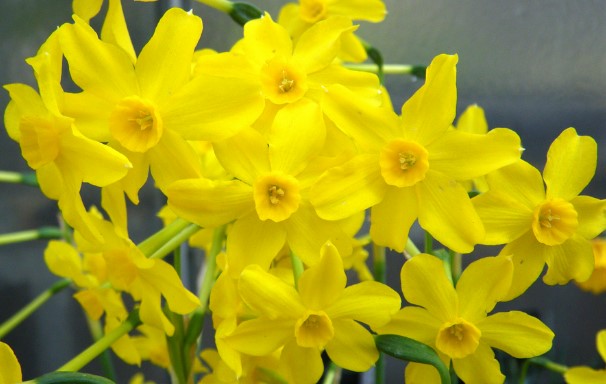Jonquil
Narcissus jonquilla
Characteristics
- Type: Bulb
- Zone: 4 to 8
- Height: 6 – 12 Inches
- Spread: 6 – 9 Inches
- Bloom Time: April – May
- Bloom Description: Yellow
- Sun: Full Sun – Part Shade
- Water: Medium
- Maintenance: Low
- Flower: Showy, Fragrant
- Tolerates: Rabbit, Deer, Drought
Culture
Jonquil is easily grown in average, medium moisture, well-drained soil in full sun to part shade. Best in organically rich, sandy loams that drain well. Plant bulbs 3-5″ deep and 3-6” apart in fall. After the flowers have bloomed, the top portion of each flower stem may be removed, as practicable, to prevent seed formation, but foliage should not be cut back until it begins to yellow. Jonquil flowers usually face the sun, so bulbs should be grown with any shade areas at the rear of the planting. Bulbs are easily grown, multiply rapidly and can be left undisturbed for a number of years.
Noteworthy Characteristics
Narcissus jonquilla, commonly called jonquil, is a bulbous perennial which was first recorded around 1750. It is a late-flowering species, end of April-May. It is native to Spain and Portugal, but has over time become naturalized in other parts of the world including much of Europe, Canada and some parts of the U.S. A jonquil typically grows to 12” tall and features 1-5 usually fragrant flowers per stem, each flower having spreading perianth segments (petals) and a small corona (cup). Flower color is golden yellow. Narrow, rush-like, dark green leaves appear in upright clumps of 2-4. Genus name honors a beautiful youth who became so entranced with his own reflection that he pined away and the gods turned him into this flower. Specific epithet refers to the rush-like leaves.
Problems
No serious insect or disease problems. Bulb rot may occur in poorly-drained soils.
Garden Uses
Popular landscape plant for beds, borders, rock gardens, foundations, woodland margins or other areas of the landscape where the spring flowers can be easily seen and appreciated. Effective when massed in front of shrubs or under trees. Best planted in quantity, i.e., from smaller groupings of at least 6 bulbs to large sweeping drifts. Mixes well with other spring-flowering bulbs.
Courtesy of Missouri Botanical Society Plant Finder
